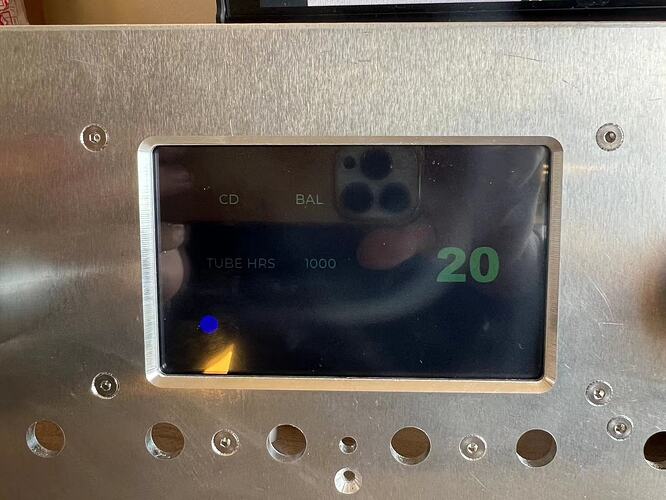Then I put the TFT code and Rotary Encoder together. This is the Code
#include <lvgl.h>
#include <Arduino_GFX_Library.h>
#include <ui.h>
/*Don't forget to set Sketchbook location in File/Preferencesto the path of your UI project (the parent foder of this INO file)*/
//GFX Display databus and driver setting
#define GFX_BL DF_GFX_BL // default backlight pin, you may replace DF_GFX_BL to actual backlight pin
/* More dev device declaration: https://github.com/moononournation/Arduino_GFX/wiki/Dev-Device-Declaration */
#if defined(DISPLAY_DEV_KIT)
Arduino_GFX *gfx = create_default_Arduino_GFX();
#else /* !defined(DISPLAY_DEV_KIT) */
/* More data bus class: https://github.com/moononournation/Arduino_GFX/wiki/Data-Bus-Class */
Arduino_DataBus *bus = new Arduino_ESP32LCD8(
11 /*DC*/, 12 /*CS*/, 10 /* WR */, 9 /* RST */,
46 /* D0 */, 3 /* D1 */, 8 /* D2 */, 18 /* D3 */, 17 /* D4 */, 16 /* D5 */, 15 /* D6 */, 7 /* D7 */);
/* More display class: https://github.com/moononournation/Arduino_GFX/wiki/Display-Class */
Arduino_GFX *gfx = new Arduino_HX8369A(bus, DF_GFX_RST, 1 /* rotation */, false /* IPS */);
#endif /* !defined(DISPLAY_DEV_KIT) */
/*******************************************************************************
* End of Arduino_GFX setting
******************************************************************************/
/*Change to your screen resolution*/
//static const uint16_t screenWidth = 480;
//static const uint16_t screenHeight = 800;
static uint32_t screenWidth;
static uint32_t screenHeight;
static lv_disp_draw_buf_t draw_buf;
static lv_color_t *disp_draw_buf;
static lv_color_t *disp_draw_buf2;
static lv_disp_drv_t disp_drv;
//测试用参数
unsigned long watch_tick = 0;
int VolumePoint[] = {10,60,100,80,30,75,45};
uint8_t VolumePointsCount = 7;
uint8_t VolumePointsIndex = 0;
int VolumeVal = 0;
char VolumeText[16];
//音量旋转编码器参数
#define ENC_A 9
#define ENC_B 10
#define MaxVolume 100
#define MinVolume 0
volatile int counter = 0;
//增加触屏板头文件
#include "touch.h"
#if LV_USE_LOG != 0
/* Serial debugging */
void my_print(const char * buf)
{
Serial.printf(buf);
Serial.flush();
}
#endif
/* Display flushing */
void my_disp_flush( lv_disp_drv_t *disp, const lv_area_t *area, lv_color_t *color_p )
{
uint32_t w = ( area->x2 - area->x1 + 1 );
uint32_t h = ( area->y2 - area->y1 + 1 );
#if (LV_COLOR_16_SWAP != 0)
gfx->draw16bitBeRGBBitmap(area->x1, area->y1, (uint16_t *)&color_p->full, w, h);
#else
gfx->draw16bitRGBBitmap(area->x1, area->y1, (uint16_t *)&color_p->full, w, h);
#endif
lv_disp_flush_ready( disp );
}
/*Read the touchpad*/
void my_touchpad_read( lv_indev_drv_t * indev_driver, lv_indev_data_t * data )
{
//已更改为GT911驱动所需格式
if (touch_has_signal())
{
if (touch_touched())
{
data->state = LV_INDEV_STATE_PR;
/*Set the coordinates*/
data->point.x = touch_last_x;
data->point.y = touch_last_y;
}
else if (touch_released())
{
data->state = LV_INDEV_STATE_REL;
}
}
else
{
data->state = LV_INDEV_STATE_REL;
}
}
//音量旋转编码器对应的中断例程
void IRAM_ATTR read_encoder() {
// Encoder interrupt routine for both pins. Updates counter
// if they are valid and have rotated a full indent
static uint8_t old_AB = 3; // Lookup table index
static int8_t encval = 0; // Encoder value
static const int8_t enc_states[] = {0,-1,1,0,1,0,0,-1,-1,0,0,1,0,1,-1,0}; // Lookup table
old_AB <<=2; // Remember previous state
if (digitalRead(ENC_A)) old_AB |= 0x02; // Add current state of pin A
if (digitalRead(ENC_B)) old_AB |= 0x01; // Add current state of pin B
encval += enc_states[( old_AB & 0x0f )];
// Update counter if encoder has rotated a full indent, that is at least 4 steps
if( encval > 3 ) { // Four steps forward
counter++; // Increase counter
if (counter > MaxVolume) counter = 100;
encval = 0;
}
else if( encval < -3 ) { // Four steps backwards
counter--; // Decrease counter
if (counter < MinVolume) counter = 0;
encval = 0;
}
}
void setup()
{
Serial.begin( 115200 ); /* prepare for possible serial debug */
//设置音量旋转编码器对应的GPIO,并关连相应中断
pinMode(ENC_A, INPUT_PULLUP);
pinMode(ENC_B, INPUT_PULLUP);
attachInterrupt(digitalPinToInterrupt(ENC_A), read_encoder, CHANGE);
attachInterrupt(digitalPinToInterrupt(ENC_B), read_encoder, CHANGE);
String LVGL_Arduino = "Hello Arduino! ";
LVGL_Arduino += String('V') + lv_version_major() + "." + lv_version_minor() + "." + lv_version_patch();
Serial.println( LVGL_Arduino );
Serial.println( "I am LVGL_Arduino" );
#ifdef GFX_PWD
pinMode(GFX_PWD, OUTPUT);
digitalWrite(GFX_PWD, HIGH);
#endif
// Init Display
touch_init();//触摸屏初始化
gfx->begin();
gfx->fillScreen(BLACK);
#ifdef GFX_BL
pinMode(GFX_BL, OUTPUT);
digitalWrite(GFX_BL, HIGH);
#endif
lv_init();
screenWidth = gfx->width();
screenHeight = gfx->height();
#ifdef ESP32
disp_draw_buf = (lv_color_t *)heap_caps_malloc(sizeof(lv_color_t) * screenWidth * 32, MALLOC_CAP_INTERNAL | MALLOC_CAP_8BIT);
// disp_draw_buf2 = (lv_color_t *)heap_caps_malloc(sizeof(lv_color_t) * screenWidth * 32, MALLOC_CAP_INTERNAL | MALLOC_CAP_8BIT);
#else
disp_draw_buf = (lv_color_t *)malloc(sizeof(lv_color_t) * screenWidth * 32);
#endif
if (!disp_draw_buf)
{
Serial.println("LVGL disp_draw_buf allocate failed!");
}
else
{
if (!disp_draw_buf2)
{
Serial.println("LVGL disp_draw_buf2 not allocated!");
lv_disp_draw_buf_init(&draw_buf, disp_draw_buf, NULL, screenWidth * 32);
}
else
{
lv_disp_draw_buf_init(&draw_buf, disp_draw_buf, disp_draw_buf2, screenWidth * 32);
}
/*Initialize the display*/
static lv_disp_drv_t disp_drv;
lv_disp_drv_init( &disp_drv );
/*Change the following line to your display resolution*/
disp_drv.hor_res = screenWidth;
disp_drv.ver_res = screenHeight;
disp_drv.flush_cb = my_disp_flush;
disp_drv.draw_buf = &draw_buf;
lv_disp_drv_register( &disp_drv );
/*Initialize the (dummy) input device driver*/
static lv_indev_drv_t indev_drv;
lv_indev_drv_init( &indev_drv );
indev_drv.type = LV_INDEV_TYPE_POINTER;
indev_drv.read_cb = my_touchpad_read;
lv_indev_drv_register( &indev_drv );
ui_init();
Serial.println( "Setup done" );
}
}
void loop()
{
static int lastCounter = 0;//音量旋转编码器计数状态重置
// If count has changed print the new value to serial
if(counter != lastCounter){
Serial.println(counter);
lastCounter = counter;
}
if(millis() > (watch_tick + 20))
{
//改变显示屏的音量显示数字
VolumeVal = counter;
itoa(VolumeVal, VolumeText, 10);
lv_label_set_text(ui_Label2, VolumeText);
}
/*
//改变音量显示数字测试
int Target_Volume = VolumePoint[VolumePointsIndex];
char VolumeText[16];
if(millis() > (watch_tick + 20))
{
if(VolumeVal < Target_Volume)
{
//音量数字增加
VolumeVal = VolumeVal + 1;
}
if(VolumeVal > Target_Volume)
{
//音量数字减小
VolumeVal = VolumeVal - 1;
}
if(VolumeVal == Target_Volume)
{
VolumePointsIndex++;
if(VolumePointsIndex == VolumePointsCount)
{
VolumePointsIndex = 0;
}
}
watch_tick = millis() + 20;
itoa(VolumeVal, VolumeText, 10);
lv_label_set_text(ui_Label2, VolumeText);
}
Serial.println(VolumeText);
*/
lv_timer_handler(); /* let the GUI do its work */
delay(5);
}
This is the code in Loop() which control the Digit of Lable1 of Screen
static int lastCounter = 0;//音量旋转编码器计数状态重置
// If count has changed print the new value to serial
if(counter != lastCounter){
Serial.println(counter);
lastCounter = counter;
}
if(millis() > (watch_tick + 20))
{
//改变显示屏的音量显示数字
VolumeVal = counter;
itoa(VolumeVal, VolumeText, 10);
lv_label_set_text(ui_Label2, VolumeText);
}
When upload the program to ESP32, the screen shows correctly, but if I turned the Rotary Encode. The TFT screen will turn to Black and shows nothing, and will not show anything anymore.




